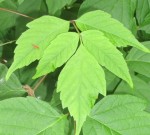 Box-elder is a short lived deciduous tree native to eastern and central North America and is also called ashleaf maple. It is often planted for its rapid growth while other more desirable trees are developing to take its place. The branches start close to the ground and have grayish brown bark with cracks and interconnected fissures. The dull green leaves are pinnately compound and have three to five sharp-pointed leaflets. Each leaflet is two to four inches long by 1.5 to 2.5 inches wide and is irregularly toothed and lobed. Small greenish male and female flowers appear on separate trees in spring. Female flowers are followed by drooping racemes of v-shaped winged seeds pods (samaras) 1.5-2 inches long that persist on the bare branches through the winter. In addition to being short-lived, the branches of box elder are brittle, the tree reseeds, and stumps sprout so the tree should be used with caution. Acer negundo californicum , a bit taller than the species, is recommended for western gardens and variegated forms that are more attractive than the specie are available for garden use.
Box-elder is a short lived deciduous tree native to eastern and central North America and is also called ashleaf maple. It is often planted for its rapid growth while other more desirable trees are developing to take its place. The branches start close to the ground and have grayish brown bark with cracks and interconnected fissures. The dull green leaves are pinnately compound and have three to five sharp-pointed leaflets. Each leaflet is two to four inches long by 1.5 to 2.5 inches wide and is irregularly toothed and lobed. Small greenish male and female flowers appear on separate trees in spring. Female flowers are followed by drooping racemes of v-shaped winged seeds pods (samaras) 1.5-2 inches long that persist on the bare branches through the winter. In addition to being short-lived, the branches of box elder are brittle, the tree reseeds, and stumps sprout so the tree should be used with caution. Acer negundo californicum , a bit taller than the species, is recommended for western gardens and variegated forms that are more attractive than the specie are available for garden use.
 Type: Deciduous tree
Type: Deciduous tree
Outstanding Feature: Rapid growth
Form: Rounded
Growth Rate: Rapid
Bloom: Small greenish flowers in spring
Size: 50-70’ H x 70-100’ W
Light: Full sun
Soil: Fertile, moist, well-drained; tolerates less
Hardiness: Zones 5-8
Care: Prune lower branches when young to develop treelike appearance; prune before growth starts in spring to avoid excessive bleeding. Protect from wind. Remove seedling to control spread.
Pests and Diseases: Box-elder bug, aphids, wilt fungus,
Propagation: Seed
Comments: Becomes misshapen in mild humid climates.